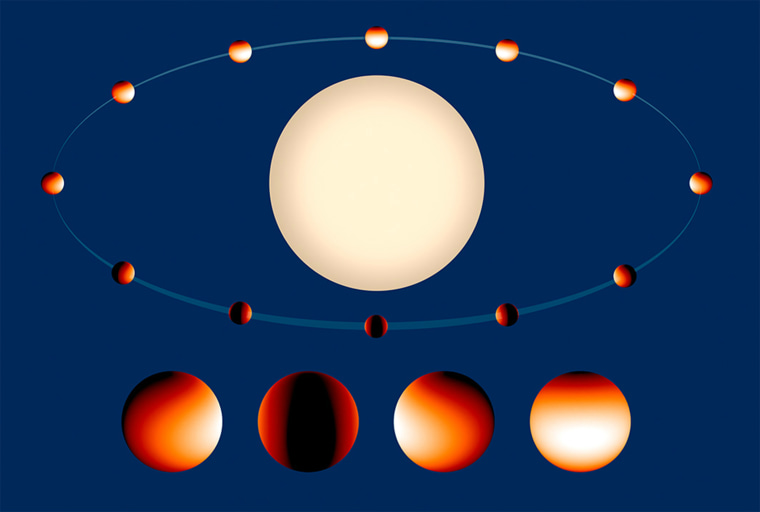There are a lot of things we still don't know about the planets around other stars that astronomers have now found by the thousands. We can learn a lot about their host stars because they give off a ton of light thanks to the fusion going on in their cores. However, the planets around them only block, reflect, or absorb and reradiate small fractions of this light. Detecting the presence of the planet is the easy part, but determining what the planet is actually like is a lot more challenging.
A planet orbiting a star will transit (or cross in front of) the star and astronomers can measure the small dip in the star's light to infer the planet's existence. That's how WASP-43b was first discovered in 2011, over 260 light years away from Earth. The "creative" name for this planet is because it was the 43rd planet candidate found by the SuperWASP (Super Wide Angle Search for Planets) survey. The star around which the planet was detected was therefore designated WASP-43 and the planet is given the suffix 'b'. Any subsequent planets discovered will be named 43c, 43d, etc.
Further analysis of how much of its star's light WASP-43b blocks, and how it makes that light shift due its tug on its star enabled astronomers to estimate its size and mass. WASP-43b is roughly the same size as Jupiter, but twice as massive and flying around its star once every 19.2 hours (for comparison Jupiter takes over 11 years to go around our Sun once). Large, Jupiter-sized planets found so close to their stars are termed "Hot Jupiters." And planets that close in and that large are perfect laboratories of sorts for astronomers to learn more about the composition and therefore the formation of planets around other stars. With such a short orbital period, astronomers had the unique opportunity to observe three consecutive "years" on WASP-43b with the Hubble Space Telescope.
Using spectroscopy, scientists were able to determine how much water was present on WASP-43b and at what temperature. It turns out the planet is so hot, that all water is vaporized and held in the upper atmosphere. Furthermore, by seeing the planet rotate, they were able to map the distribution of water vapor from pole to pole on the planet. The amount of water detected on WASP-43b tells us more about the likely composition of the gaseous nebula that it and its star likely formed from. By studying as many planetary systems as possible in this way, astronomers hope to better constrain their understanding of planet formation which could eventually lead to the ability to predict which stars are likely to host the most Earth-like (i.e., habitable) planets.
Here's some geek that took place recently on our planet:
- Mantis shrimp can see polarized light and just inspired a new camera for detecting cancer.
- Drop dead gorgeous gallery of winning photos from the 2014 National Geographic Photo Contest.
- These five Swedish scientists had a bet to see who could get the most Bob Dylan lyrics into their published work.
- High intelligence correlates with liking thunderstorms, The Colbert Report, science, and curly fries on Facebook. Freaky insight into your personality from computer algorithms run on your social media posts.
- I want every single item in this "history of science" auction by Bonhams Auction House.
- Six weird ways humans are altering the planet that are not what you might think.
- The Large Hadron Collider is getting ready to start running again after a two year hiatus.
- NASA is looking into the "deep sleep" option for long-term space travel. We are another step closer to living in a sci-fi world.
- The chemistry of New York City's water is perfect for making the ideal bagel.
- The Nobel Prize for Physics went to three researchers who developed blue light-emitting-diodes (LEDs). Sounds unimportant, but think again!
For more on how LEDs work (and light bulbs in general), check out this great video by Minute Physics:
Keep on geeking! @Summer_Ash
